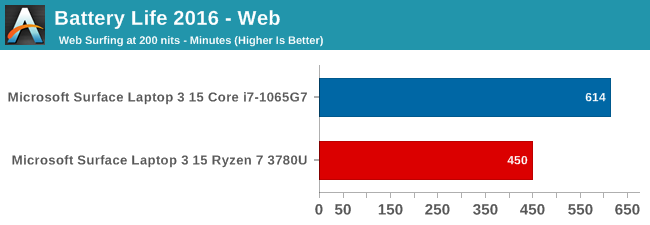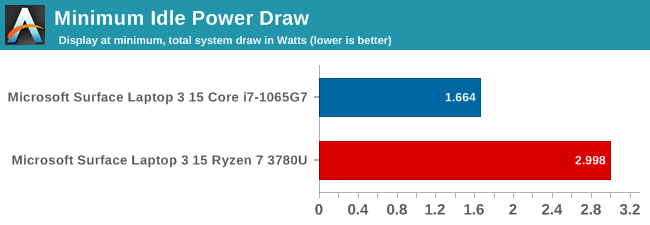The Microsoft Surface Laptop 3 Showdown: AMD's Ryzen Picasso vs. Intel's Ice Lake
by Brett Howse & Andrei Frumusanu on December 13, 2019 8:30 AM ESTPlatform Power
Performance aside, the other side of the coin is battery life. AMD made big gains in battery life with the Ryzen 3000 series, somewhat addressing the power requirements of the platform and getting rid of some of the excessive idle power draw, but they are still using DDR4 on their mobile platform, which puts them at a disadvantage right out of the gate. Intel has made very good gains in battery life over the last several generations, and the move to 10 nm for Ice Lake also brought along LPDDR4X support. Most of the previous generation laptops stuck with LPDDR3, unless the manufacturer needed more than 16 GB of RAM, where they’d be forced to switch to DDR4. Finally adding LPDDR4X support is something that Intel has needed to do for a while, and ironically Intel’s flagship Core product line lagged behind their low-cost Atom lineup which did support LPDDR4.
Web Battery Life

The Ryzen 7 3780U powered Surface Laptop 3 was slightly under the Ryzen 5 device we tested at launch, but still in the same range. The AMD system isn’t helped very much by Microsoft only offering a 46 Wh nominal battery capacity, which is rather undersized for a 15-inch laptop. The Ice Lake device, as we’ve seen before, was much more efficient under load, offering a sizeable battery life lead.
Idle Power
One of AMD’s biggest challenges was to get their laptop SoC into a premium device, and with the Surface Laptop 3 they have succeeded. Microsoft has shown themselves as being adept at squeezing battery life out of devices, with low-power displays, and good internal components to minimize power draw. Here Intel has held a considerable advantage over the last couple of years, and the move to 10 nm should, in theory, help as well.
To test the idle power draw of both systems, the battery discharge rate was monitored with the screens fixed in at 5.35 nits, to minimize the power draw of the display on the result. Normally we’d prefer to have the display completely off for this test, but Microsoft’s power plan on the Surface Laptop actively turns off the laptop when the display times out.

The Ice Lake system was able to go all the way down to right around 2 Watts of power draw – and sometimes slightly under – with as low as 1.7 Watts seen. We’ve seen under 1 Watt of draw on an 8th generation Core Y series processor, and around 1.5 Watts on the same generation U series, so considering the display is not completely off on the Surface Laptop, the 2-Watt draw is quite reasonable.
The Picasso system was not quite as efficient, drawing 3 Watts at idle. This is in-line with the results we’ve seen on other Picasso systems and explains the lower battery life results on the AMD system. AMD made big gains moving from Raven Ridge to Picasso, but I’m sure the team is looking forward to the 7 nm Zen 2 coming to their laptops, which we hope will address this further.










174 Comments
View All Comments
Zoolook - Saturday, December 21, 2019 - link
@RSAUser I think you nailed it, it's better for their bottom line to dedicate 7nm chips to products with higher margins.shabby - Friday, December 13, 2019 - link
What is amd waiting for with zen 2 for mobile? Are they prioritizing desktop and server chips first or is there a lack of capacity at tsmc with everyone hogging the 7nm process?RBD117 - Friday, December 13, 2019 - link
I think it's a mix of everything. Renoir is being worked on actively but AMD doesnt have enough resources to do all of Ryzen AM4, EPYC, and Ryzen Mobile at the same time. The desktop and server chips were prioritized first as those have clear wins over Intel solutions. Mobile however requires a lot more work with battery life and performance optimization. And yeah, we already see chip production issues with Ryzen 16 and 12-core as it is with most of the chips going to EPYC so Zen2 mobile would just add more capacity issues.Targon - Friday, December 13, 2019 - link
AMD should be releasing the Zen2 laptop chips at or around CES 2020(in another three weeks). Microsoft was probably preparing the Surface Laptop a good five months ago so AMD just didn't have samples ready for Microsoft at that time.sing_electric - Friday, December 13, 2019 - link
Realistically, TSMC's 7nm process (used in Zen 2's compute chiplets) is expensive and capacity-constrained. AMD gets around this on desktop by creating a separate IO die on an older, cheaper process, but that doesn't scale well to mobile.To get Zen 2 on mobile, they'd likely need everything - compute, IO and GPU - to be on 7nm, and the chip would be considerably larger than (desktop) Zen 2's compute chiplet.
AMD basically had a choice - for a given number of 7nm wafers, they could get a few mobile APUs or a lot more desktop CPUs (and GPUs for their 7nm options). The margins are much better doing the latter, so that's what they did.
There's also the fact that we don't know what their agreement is with Global Foundries on 14/12nm wafers - we do know that AMD's agreement with them didn't require GloFo to finish its 7nm process. AMD has a commitment to buy some number of wafers from GloFo per year for a certain length of time, and it's likely that is a factor as well.
lmcd - Friday, December 13, 2019 - link
Disagreed -- cheaper IO dies have worked on mobile for years. The "cheaper" process is literally the process Zen+ shipped with.Problem is entirely integration -- now that Navi (a major release) has shipped, AMD can integrate the current version into chiplet form, then port those integrations to the incremented version of Navi ready to ship next year. Since the chiplets provide a substantial level of decoupling, incremental upgrades should be reasonably easy to integrate.
RSAUser - Friday, December 13, 2019 - link
Doubt the I/O die size matters in this case, doesn't scale down well so not an issue.Most likely a supply issue and getting Navi to integrate.
scineram - Monday, December 16, 2019 - link
What Navi?AnGe85 - Friday, December 13, 2019 - link
AMD is a smaller company with fewer resources, as you can see with various things. The step by step Navi Launch (currently only Navi 14 is additionally available), delayed 3950X launch, the fragmented Threadripper launch, not until early 2020 Renoir with Zen2, but only combined with Vega (not Navi) and there's still the question when desktop APUs will hit the market.The new suface models presumably have been in development for about a year or even longer. There was no mobile Zen2 in sight ... and this also applies to Apple's Mac Pro and stupid demands like "it should have been Threadripper, not Xeon W". There was no appealing Threadripper available (the old 2000 series still has various flaws and limits and the Mac Pro is an even more complex platform).
Additionally at this point, I would assume, that Microsofts strategy (with the two AMD and ARM models) is more about keeping Intel in check according to pricing and cooperation.
The ARM Pro X has obvious limits and Microsoft also knew about AMDs comparability in advance. Additionally you can assume, that there is a good reason for Microsoft to offer channel consumers to the AMD 15" model (and to limit the Ice Lake model to business users), most likely, because they have to sell x K SKUs to make this experiment (or this Intel pressurizing model?) worthwhile. Maybe with next surface updates in 2021 AMD will be more competitive.
5080 - Friday, December 13, 2019 - link
Margins. EPYC, Threadripper have a much higher margin than mobile APU's.